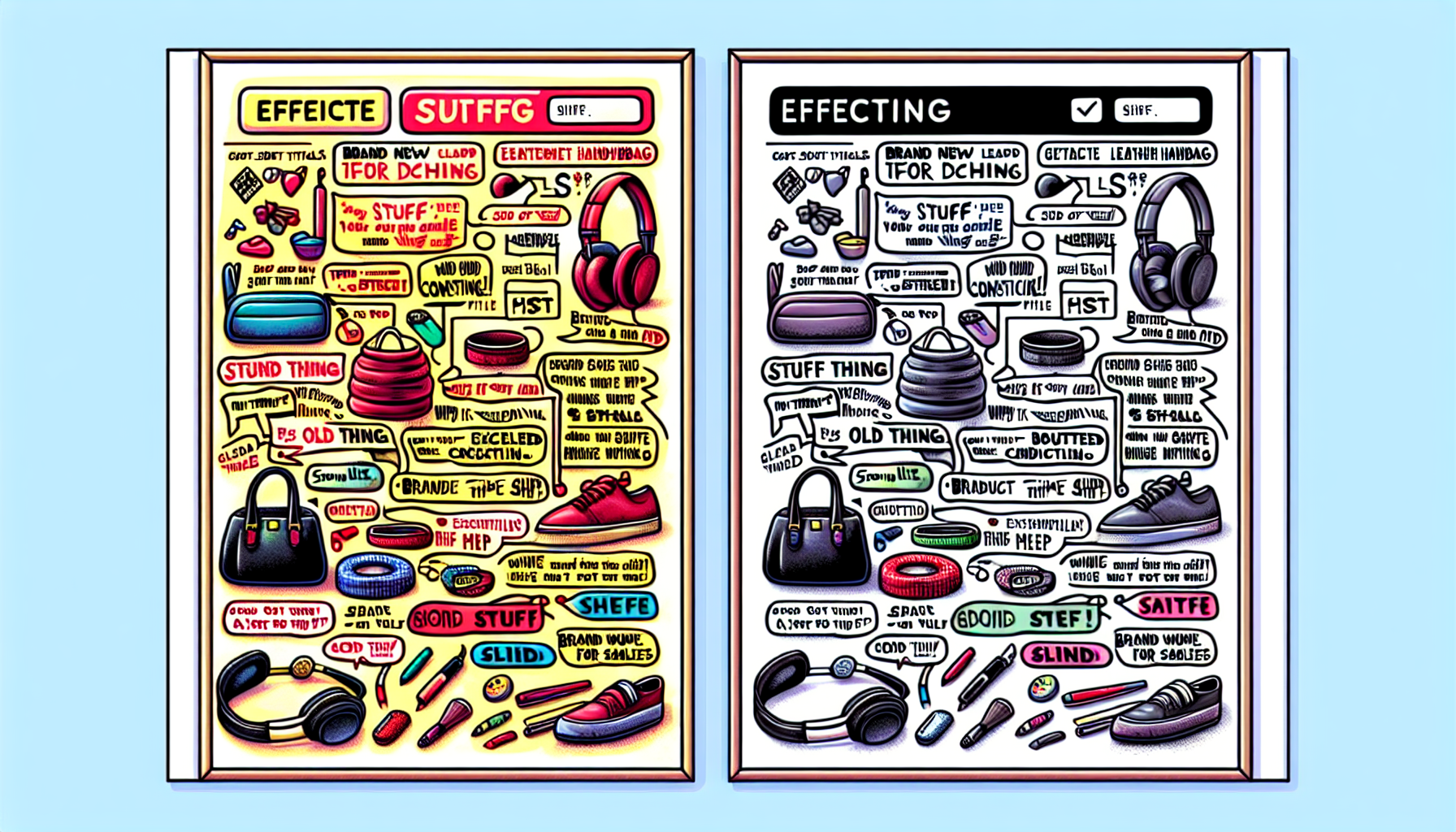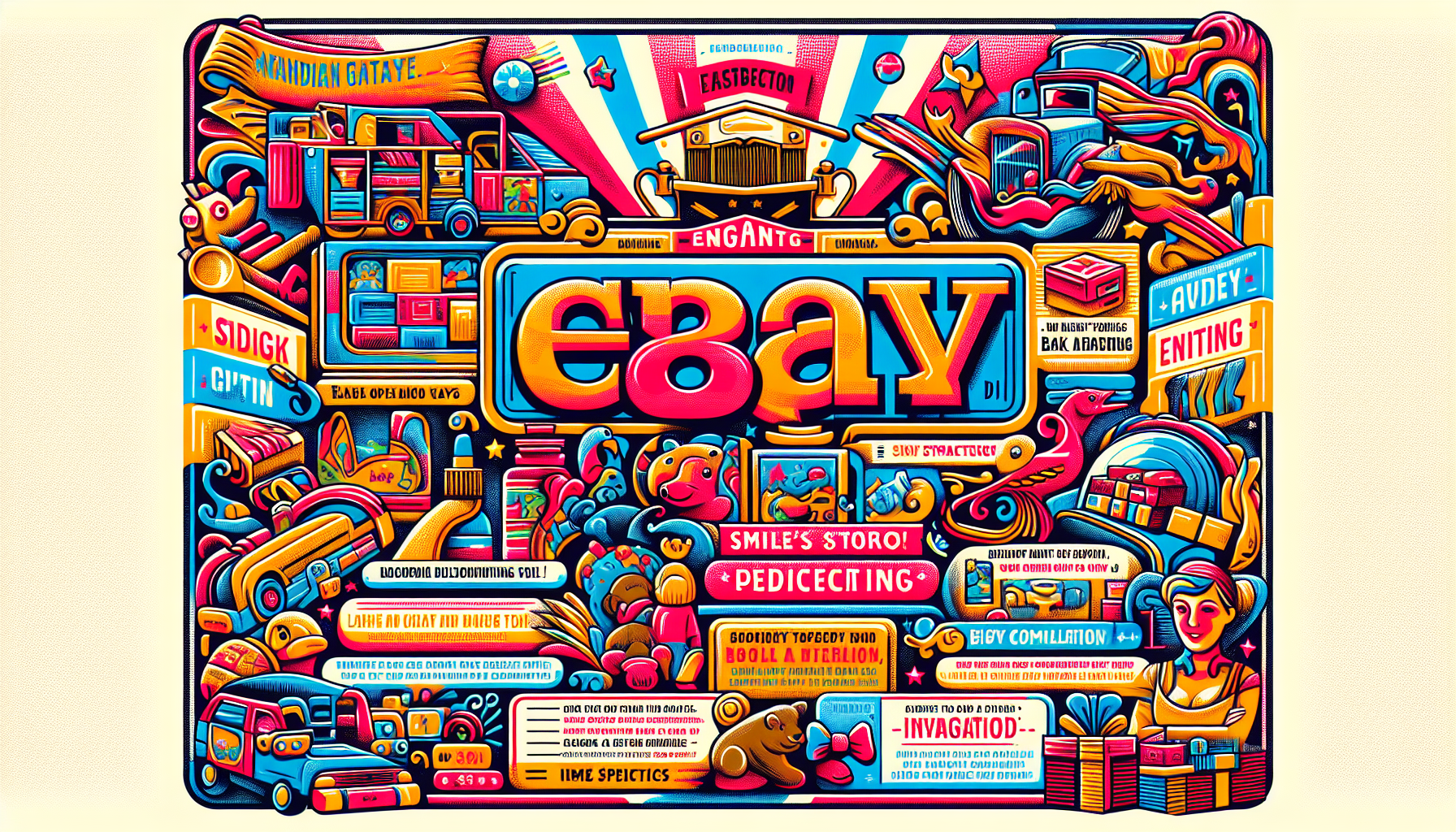Looking to improve your eBay listings? This guide will show you how to craft effective eBay product titles. Learn to use keywords wisely, avoid common mistakes, and follow best practices for optimizing your titles.
Understanding eBay’s Title Guidelines

Creating effective eBay titles involves more than just combining a few keywords. Following eBay’s guidelines ensures your listings remain compliant and optimized for search. eBay marketplace allows up to 80 characters per product title, so it’s important to choose your words carefully to attract buyers without overloading the title.
Using relevant keywords in your titles and descriptions can significantly enhance your listing’s visibility in eBay’s search results. However, avoid overusing special characters, as this can cause your listings to be flagged or disallowed. Understanding and following these guidelines can improve your listing’s performance and increase your chances of making a sale.
Common Pitfalls in eBay Titles and How to Avoid Them
Even the best intentions can lead to common pitfalls when writing eBay titles. Mistakes like keyword stuffing, overuse of special characters, and misleading brand information can decrease your visibility and deter potential buyers.
Here are some common pitfalls and how to avoid them.
Overusing Keywords (Keyword Stuffing)
Keyword stuffing might seem like a quick way to get noticed by search engines, but it often backfires. Titles overloaded with keywords can appear artificial and detract from their quality. This practice not only makes your listing less appealing to potential buyers but can also dilute the title’s meaning, making it less effective.
Instead of overloading your title with keywords, aim for clarity and relevance. Subtitles and item specifics can be used for additional keywords to keep the main title clear. This approach will increase your chances of appearing in relevant searches without overwhelming the reader.
Excessive Use of Special Characters
Special characters can add a bit of flair to your titles, but too many can make them look spammy and unprofessional. Overuse of special characters can also create a perception of unprofessionalism, which might deter potential buyers.
To maintain a professional appearance, use special characters sparingly and only when necessary. Stick to standard punctuation and avoid excessive capitalization to keep your title clean and readable.
Misleading Brand Information
Accurately representing the brand in your eBay title is crucial for building trust with buyers and complying with eBay’s policies. Misleading brand information, such as suggesting a third-party charger is made by a well-known brand like Samsung, can lead to a loss of buyer trust and potential issues with eBay.
Always ensure your product titles accurately reflect the brand and product being sold. This not only maintains credibility but also helps you stay within eBay’s guidelines, protecting your listings and seller account from potential risks.
Crafting Effective eBay Titles: Best Practices
Creating optimized eBay titles can significantly boost your listings’ visibility and attract potential buyers. With Koongo, merchants can enhance this process by utilizing the attribute composition feature to build or improve eBay titles across multiple products. This feature allows you to create a title using various product attributes, such as brand, model, color, and size, ensuring that your title is both descriptive and relevant.
By combining multiple attributes, you can generate detailed and structured titles that make your listings more appealing and aligned with eBay’s search algorithms. For example, instead of a generic title like “Running Shoes,” using attribute composition in Koongo can help you create a title like “Nike Men’s Air Zoom Running Shoes – Size 10, Black.”
Focus on Clarity and Relevance
When crafting eBay titles, clarity and relevance are paramount. Ensuring your title is clear and directly related to the product being sold captures buyers’ attention and aligns with their search queries. Use descriptive words wisely to highlight key features and benefits without wasting valuable title space.
Following eBay’s guidelines and focusing on buyer needs helps create titles that attract attention and encourage purchases. The first thing a potential buyer sees is your title, so ensure it stands out for the right reasons.
Improving Titles Using Attribute Composition with Koongo
With Koongo’s attribute composition, you can automatically build product titles using a combination of selected attributes from your product data. This helps in maintaining consistency across your listings while saving time on manual editing. By leveraging attributes such as product type, brand, condition, and features, you can generate unique and comprehensive titles that stand out in search results.
For instance, if you’re selling a range of electronic gadgets, you could use attributes like brand, model number, and technical specifications to create titles such as “Samsung Galaxy S21 Smartphone – 128GB, Phantom Gray, Unlocked.” This approach ensures that all essential product details are covered, making your listings more attractive to potential buyers.
Importance of Correct Spelling and Grammar
Correct spelling and grammar in your eBay titles enhance your product’s credibility and visibility in search results. Spelling mistakes can reduce your listing’s visibility and create a negative impression of your professionalism.
Ensuring your titles are free of spelling errors and grammatical mistakes improves search visibility and builds trust with potential buyers. A well-written title demonstrates care and attention to detail, which can make a significant difference in a competitive marketplace.
Using Descriptive Words Wisely
Descriptive words in eBay titles should emphasize key features and details to make the most of your title space. Including precise adjectives can help highlight unique aspects of your product without taking up too much space.
Using concise, descriptive terms helps convey crucial item features effectively and attract potential buyers. This approach makes your title informative and appealing, increasing the likelihood to sell a sale.
Examples of Good and Bad eBay Product Titles

Seeing examples of good and bad eBay product titles can be incredibly helpful. Effective titles often include clear descriptions and relevant keywords, making them easy to read and engaging. For instance, a good example might be “Apple iPhone 13 Pro Max – 256GB – Silver (Unlocked)” which clearly states the product, key features, and condition.
On the other hand, ineffective titles might include keyword stuffing or unprofessional formatting, like “iPhone 13 Pro Max Apple 256GB Silver Unlocked New” which is cluttered and harder to read. Understanding these differences helps sellers refine their approach, creating titles that attract buyers and drive sales.
These examples can help you avoid common mistakes and master the art of writing effective eBay titles.
Enhancing Titles with Subtitles and Item Specifics

Subtitles and item specifics enhance your eBay titles by providing additional information that complements the main title, making your listing more visible and appealing to buyers. Although adding subtitles comes with an extra fee, the potential increase in visibility and sales can make it worthwhile.
Including item specifics allows you to describe attributes such as size, color, and brand, making your listings more informative and accessible to buyers. This added detail can make your products stand out and help potential buyers find exactly what they’re looking for.
Optimizing Titles for Mobile View
With over 60% of eBay listings accessed via mobile devices, optimizing your titles for mobile view is essential. Mobile commerce sales are on the rise, so eBay sellers need to ensure their listings are mobile-friendly.
For mobile optimization, use a font size of at least 16 CSS pixels for better readability and avoid horizontal scrolling by formatting listings to fit mobile screen dimensions. Simple formatting, like using bullet points and clear color contrast, can enhance readability on mobile devices.
Leveraging Data for Better Titles
Using data to refine your eBay titles can greatly improve their effectiveness. Analytics tools can identify high-performing keywords based on buyer searches, allowing you to optimize your titles for better visibility and relevance.
Tools like ZIK Analytics Title Builder generate long-tail and generic keywords, offering insights into average searches and competition. Competitive analysis of similar eBay listings can help you refine your title strategies and create standout titles in the marketplace.
Key Takeaways
- Follow eBay’s title guidelines to improve visibility and compliance, using relevant keywords without overloading your titles.
- Avoid common pitfalls like keyword stuffing, excessive special characters, and misleading brand information to maintain professionalism and clarity.
- Enhance your titles with subtitles and item specifics, optimize for mobile view, and leverage data analytics to refine your listings for better performance.
Summary
Mastering eBay product titles involves understanding guidelines, avoiding common pitfalls, and employing best practices. Clear, relevant, and well-crafted titles can significantly increase your listings’ visibility and drive sales. By focusing on proper spelling, grammar, and the strategic use of descriptive words, you can create compelling titles that attract potential buyers.
Remember to leverage data and analytics to refine your titles continually. With these strategies in hand, you’re well on your way to becoming an eBay title master. Happy selling!
Frequently Asked Questions
Why is it important to adhere to eBay’s title guidelines?
It’s crucial to stick to eBay’s title guidelines because it boosts your listing’s visibility and helps you stay compliant, leading to better sales performance.
What is keyword stuffing, and why should I avoid it?
Keyword stuffing is when you overload your content with keywords, making it feel unnatural and off-putting to readers. It’s best to avoid it because it can hurt your site’s credibility and search engine rankings.
How can I enhance my eBay titles with subtitles?
Enhancing your eBay titles with subtitles can really boost visibility and appeal by providing extra information. Just keep in mind that adding subtitles comes with an additional fee.
Why is mobile optimization important for eBay titles?
Mobile optimization is essential for eBay titles because over 60% of listings are viewed on mobile devices, ensuring you effectively reach a larger audience. If you want your products to be seen, optimizing for mobile is a must!
How can I use data to improve my eBay titles?
To improve your eBay titles, use analytics tools to find high-performing keywords that boost visibility and relevance. Incorporating these keywords into your titles can lead to better sales.
Start your 30-day free trial of Koongo today and upload your product data to begin automating your marketplace management. Afterward, follow the online marketplace guide to set up the desired channel integration—whether it’s Amazon, eBay, or another channel. Our setup instructions are designed to be easy to follow, ensuring a smooth onboarding experience.
If you have any questions, please don’t hesitate to contact us at support@koongo.com. Our team is here to help you every step of the way, making sure your experience with Koongo is seamless and successful.
Continue reading →
 EN
EN 
